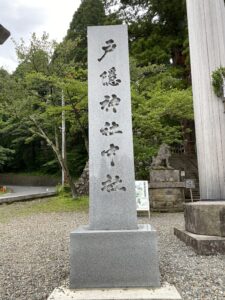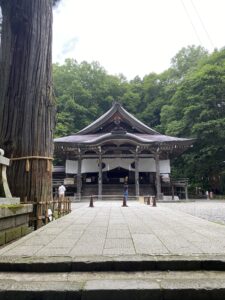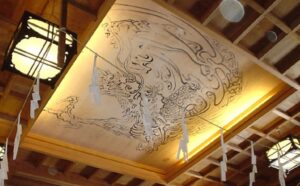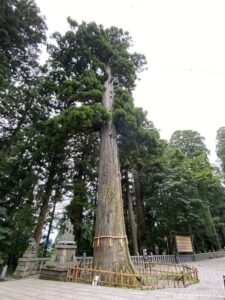After you go back to Kanmichi and go further up, you can find the stone monument on which name of Chu-sha Shrine curved.
 Stone Monument of Chu-sha Shrine
Stone Monument of Chu-sha Shrine
After you passed the stone monument, you will see the trii date.
 The Torii Gate
The Torii Gate
After passed the trii date and go up the stairs, you will see the main hall of Chu-sha Shrine.
 The Main Hall of Chu-sha Shrine
The Main Hall of Chu-sha Shrine
The enshrined deity of Chu-sha Shrine is Ameno-yagokoro-omoikane-no-mikoto who is father of Ame-no-uwaharu-no-mikoto (the god protecting women and children) enshrined in Houko-sha Shrine. He created a type of sacred music and dance called “Iwatokagura” which was the trigger that Amaterasu Oomikami (Sun Goddess) opened Ama no iwato (the cave of heaven). It is said that he has great power in academic achievement, thriving business, better fortune, avoidance of bad luck and safety of one’s family.
On the ceiling of the main hall, there is a reproduced dragon paint which Kyosai Kanabe who belonged to Kano school of Japanese painting originally painted.
 Dragon Paint on the ceiling of Chu-sha Shrine
Dragon Paint on the ceiling of Chu-sha Shrine
There is a sacred tree near the main hall that age is over 700 years.
 The Sacred Tree
The Sacred Tree
After you worshipped at Chu-sha Shrine, you may continue climbing up to Kuzuryu-sha Shrine enshrines Kuzuryu-no-ookami (the god associated with the local area, the god of water and good harvest) and Oku-sha Shrine enshrines Ame-no-tachikara-no-mikoto (the god of strength).
On the way to Kuzuryu-sha Shrine, you will see the Nyonin-do Ato which was the place for women to pray to Oku-sha Shrine in Mt. Togakushi from the distant place, since women had been prohibited from entering Mt. Togakushi until Edo Period. In the past, there was a praying hall called Nyonin-do there.
 Nyonin-do Ato
Nyonin-do Ato
The stone monument in the right of the photo above says that the road to the right direction leads you to Echigo road and the road to the left direction leads you to Oku-sha Shrine which women were prohibited to go on to before Meiji Period.
There is a stone called “Bikuni-ishi” near Nyonin-do Ato. There is a legend that a nun called bikuni who crossed over the Nyonin-do would change into a stone. This stone is called Bikuni-ishi.
Issa Kobayashi who is a famous Japanese haiku poet visited here and composed a haiku.
Haiku : Aki kaze no fuki mo herasazu bikuni-ishi.
English : Bikuni-ishi (The stone) does not reduce the blows of a cold wind.
 Stone Monument the haiku of Issa curved on
Stone Monument the haiku of Issa curved on
Your visit to the 5 shrines of Togakushi-jinja Shrine is continued.




Comments